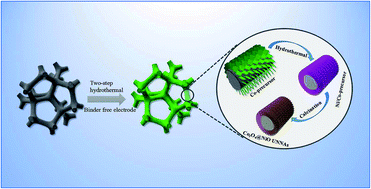Ultralayered core–shell metal oxide nanosheet arrays for supercapacitors with long-term electrochemical stability†
Abstract
High-stability electrodes are highly desirable for practical supercapacitor applications, which is closely linked with the high utilization and degradation of active materials. Herein, core/shell ultralayered Co3O4@NiO nanosheet arrays were developed by a two-step low temperature hydrothermal method. A porous and thin NiO shell was epitaxially grown on the surface of an ultralayered Co3O4 nanosheet. As a supercapacitor electrode material with good electrochemical performance, the prepared ultralayered Co3O4@NiO core/shell nanosheet array electrode demonstrated a notably enhanced specific capacitance (715 F g−1 at 0.5 A g−1) compared with the pure Co3O4 nanosheets. The elegant combination of NiO and Co3O4 nanostructures in the nanosheet arrays showed promising synergistic effects for capacitors with greatly enhanced performance (30.2 W h kg−1 at a power density of 201.5 W h kg−1) and good cycling stability with 102% of the initial capacitance after 6000 cycles. The as-prepared core/shell ultralayered Co3O4@NiO nanosheet arrays with enhanced performance could be considered as a promising electrode material for high-performance supercapacitors.


 Please wait while we load your content...
Please wait while we load your content...